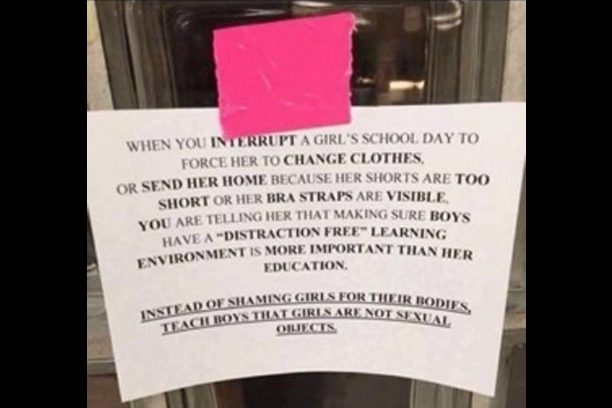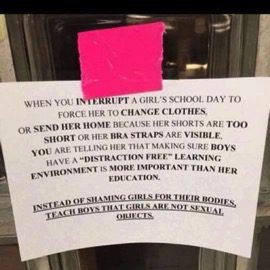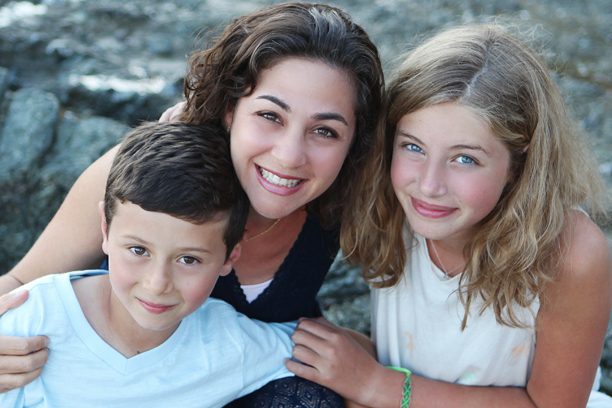
by admin | Aug 29, 2016 | Uncategorized

On the middle school website the stated purpose “for student dress and grooming standards is to foster an educational environment.” Except at back to school night I heard a different story from the gym teacher. The presentation started out predictably dull. The kids were slated for hockey (wow!) and football (ooh!) and soccer (fantastic!) and, oh, the female gym teacher almost forgot to mention–girls were not permitted to wear yoga pants or leggings, because it might cause the boys to spring an erection.
Whoa. What?
Yes, you read that correctly. My daughter, barely 13, cannot wear yoga pants or leggings in gym, because some kid might be aroused. The teacher elaborated. She said boys this age had a difficult time controlling themselves. They could be stirred by the sight of a girl in exercise pants in exercise class. The resulting erection could be embarrassing. Hence, in order to prevent this type of humiliation for the boys the gym teacher required the girls put shorts over their exercise pants.
It all happened so fast. Did I actually hear the teacher correctly? After class I went back to speak with her again. She clarified. Well, she tried to clarify, as one tries to dig her way from a pile of quicksand. She told me one of the reasons this is an issue is because she requires the students to tuck in their shirts, you know, to be respectful. She believes when the girls have their shirts tucked in, wearing yoga pants, it’s just too revealing for the boys. Got it?
Um, no. I do not. In fact, I am horrified.
In the 1960s and ’70s, the girls all wore miniskirts that barely covered their rears, and the boys still managed to graduate. Walk on to any college campus today and one spots students wearing yoga pants, sweatpants and even pajamas to class. Somehow an educational environment is still maintained. The male students find a way to suppress any possible sexual feelings while in the classroom because it would be inappropriate otherwise.
Yet middle and high school dress codes are popping up with reckless abandon around the country. Girls can’t wear tank tops or spaghetti straps on dresses. Skirts need to be no shorter than fingertip length. Just fire off a quick Google search, and you’ll be startled by the number of schools limiting what girls–but often not boys–can wear. It’s happening in Kentucky. It’s in Texas. And in Indiana. And in Oregon. The girls in New Jersey were so fed up with the insinuation that they are a disruption they created the Twitter hashtag #Iammorethanadistraction.
Why is there a sudden problem with clothing being so terribly distracting in school?
The objectification of a woman’s body is pervasive in our culture. I don’t know of a single woman who hasn’t experienced cat calling, unwanted whistling, fear of being followed, sexual harassment or sexual assault. A national poll conducted by The Washington Post and Kaiser Family Foundation in 2015 reported that 25 percent of women attending college experienced unwanted sexual incidents. The problem isn’t that we aren’t creating an educational environment in school. It’s that we aren’t teaching boys and young men that women are not sexual beings first and foremost.
Banning yoga pants for the purpose of avoiding unwanted erections sends the message that boys are programmed to respond and can’t help what their bodies do. Boys and men are responsible for their actions. It’s no wonder some don’t stop unwanted sexual advances when they hear a woman saying, “No.” Short skirts and leggings don’t cause sexual advances–the inability to manage one’s desires does.
Instead of draconian dress codes what we really need are conduct codes. Enough with stifling the girls to help the boys control themselves. That’s demeaning to the boys as much as it is to the girls. Why not state the expectation that on school grounds any sexual activity or expression will not be tolerated. Children can learn to control themselves when there are clear expectations for how to behave with consequences for misconduct.
It isn’t the responsibility of my daughter (or any daughter) to help boys manage sexual urges. It is the responsibility of the boys. It isn’t OK to start shaming girls about their bodies by telling them to obsessively cover up. And girls should not have to disregard their own comfort to protect the comfort of the boys around them.
I came home from back-to-school night and discussed the gym teacher’s remarks with a male friend. He thought I shouldn’t have told my daughter the reason she couldn’t wear yoga pants. I disagree, strongly. Girls need women to break down these issues when they are young, before they are shamed or harassed or raped. It’s one step closer to showing girls that wearing a short skirt isn’t akin to asking for “it”. I need to show my daughter what saying no looks like. And I need to help change this policy so she can see what change looks like.
Shielding my daughter from the realities of being a woman will not help her stay safe in any environment, educational or otherwise. Speaking up about, in her presence, will.
…
Side Note: After speaking with the school’s assistant principal I was assured the gym teacher would be reprimanded for her inappropriate remarks, and the school is working on crafting a policy for gym clothes.


by admin | Jan 26, 2016 | Uncategorized

Not too long ago I received an email asking if I wanted to try out some new snacks for free. The goal of the email was for me to taste the product and write a glowing review thus providing some nice advertising for the company. I like snacks and I especially like the free kind so I signed up.
A few weeks later my snack pack arrived. Quite honestly I was prepared to dislike these chips. I am all for healthy eating but the chips were pushing it with gluten free, vegan, kosher, low fat, non-GMO and baked. How could something with all of those restrictions actually taste good?
Well, they do taste good. Not just good but delicious and so satisfying. These chips are made from peas and corn with a bit of oil and salt. They are as crunchy as Doritos with none of the guilt. The chips are also dry to the touch which is different from other pea crisps that I have had. I tasted three varieties: Original, Sriracha and Aged White Cheddar. My favorite by far is the Original. The Sriracha was too garlicky for me but some will like that. The cheddar ones were tasty too but I preferred the plain ones.
What I really like about these chips is that they are really really crunchy and really healthy. One good-sized portion has only 2.5 grams of fat, 120 calories, 4 grams of protein and 1 gram of fiber. You really can’t beat that kind of nutrition in a snack.
My kids tasted the snacks and no one was particularly moved by them. But I think they might grow on at least my son. So the bottom line is that I got the snacks for free but now I am a believer. I will have to head to Whole Foods for my next supply.
Are you wondering how you too could get free snacks? If you want to try The Real Deal Veggie Chips for free here is your chance. Send your email address to me at [email protected] and I will raffle off a package of chips. Happy snacking!


by admin | Dec 12, 2015 | Uncategorized

Photo credit: Noel Besuzzi
A few weeks ago Mark Zuckerberg, the chairman and chief executive of Facebook, made an amazing and unprecedented announcement on, of course, Facebook . It had nothing to do with the company. It was a personal post stating that he had decided to use two months of paternity leave when his daughter was born. He cited research that showed that outcomes for children and families are better when working parents took time off to be with their newborns.
Contrast Zuckerberg’s announcement with that of Yahoo CEO Marissa Mayer. Several years ago she took a mere two weeks off after the birth of her son. She just gave birth to twin girls and recently revealed on her Tumblr page that she planned to approach the pregnancy and delivery much like she did with her son by, “taking limited time away and working throughout.”
The backlash against Mayer was vicious. Some condemned her for minimizing and even trivializing the importance of maternity leave. Many wondered why she bothered to have a child if she didn’t want to spend time with it when it was born. A small dissenting few thought she was an excellent example of a woman at the top working hard at her job. But in a blog post written for the Lean In website founded by another powerful working mother, Sheryl Sandberg, Mayer explained that her brief maternity leave had little to do with her desire to be a mother or her thoughts on maternity leave. “After 13 years of really hard work at Google,” Mayer wrote, “I had been envisioning a glorious six-month maternity leave. However, if I took the new job, a long leave couldn’t happen. The responsibilities were too big, and time was of the essence–it just wouldn’t be fair to the company, the employees, the board, or the shareholders for me to be in the role, but out for an extended period of time.”
And there it was. Mayer knew that if she wanted to succeed in her high-level career she would have to sacrifice time with her children. It is unclear if Mark Zuckeberg doesn’t have the same pressure because he is a man or because he is the head of what was once his own company. Being fired isn’t a probable outcome for him whereas Mayer is in real danger of being fired as her company’s profits decline.
The issue of leave after a baby is born is a hot topic. The United States is far behind the rest of the industrialized world in providing a paid opportunity for parents to bond with their newborn child. However, focusing on the few months after the baby is born only scratches the surface of some of the issues working women face once they become mothers.
Just before Zuckerberg and Mayer’s announcements, my new book agent called to tell me she was leaving the business. I was disappointed, and I wanted to know why, a mere month after signing me, she decided to bolt. As soon as she explained, though, I understood. With a sad resignation in her voice, my agent said she needed to quit her dream career in order to spend more time taking care of her young son. She said she was 100-percent certain the decision was the right one, though she seemed plenty unsure. What if she was making a huge mistake leaving her career? What if she regretted it and ultimately wanted her job back–but only after it was too late? Would the publishing world move on without her? Proceed forward as if she never existed? She loved her son. She loved her job. She wanted … both. But knew it was impossible.
These were the same struggles I confronted during my first pregnancy 13 years ago. After my daughter was born I changed jobs several times trying to balance my need to be with my child and my career interests. At the end of my rope in my current job I ended up accepting a seasonal summer job as a social worker in a sleep-away camp for homeless children. Although only a temporary position it was the job I was meant to do.
That summer I slept at the camp every other night. On the days away from my nearly one-year-old daughter I missed her terribly. Shouldn’t I be home with her instead of taking care of someone else’s kids? What milestones was I missing for the sake of my job? It was a hard summer but I made it through and by the end I was offered the job for which I worked the previous ten years. I was hired to be the full-time camp director at another sleep-away camp for low-income children. The job came with housing, and I imagined running the camp and being a mother simultaneously. We would be one big camp family.
But it didn’t happen that way. The dream wasn’t real. Real life was that I worked 16 hours daily, and I almost never saw my daughter. One day my child had a seizure while out with the babysitter. I wasn’t there and I couldn’t leave camp to meet her in the emergency room because I was also needed at the camp. You cannot imagine the pain a mother feels when she cannot be with her sick child because of a career choice.
Another year passed and I became pregnant with my second child. Faced with the thought of raising two children with my hours I decided to leave my job and my career. It seemed there was no way to be successful at work and successful at home in equal measure. Something had to be sacrificed and I wasn’t willing to sacrifice my children. It only took three years for me to realize that being the career woman I imagined and the mother I wanted to be were incongruent. I wouldn’t run a camp for special needs children. I wouldn’t travel the world on rescue missions. And I wouldn’t be making the world a better place in my job anymore. That hurt. I was a social worker. That’s who I was and what I worked for. Who was I now if I didn’t work?
In Sheryl Sandberg’s 2010 TED talk that was the inspiration behind her bestselling book Lean In she told women they have to sit at the table with male leaders . They have to keep their hands raised even after the men put theirs down. And they have find partners who are their equal in parenting. Instead of leaning back (away from a successful career to raise children) working mothers needed to lean in more. Sounds great. The problem is that there is no way to lean in at work and lean in at home. And what Sandberg and Mayer have that most other working mothers don’t is millions of dollars to spend on the highest quality of daycare.
In the years since I left full-time employment in an agency I have reinvented myself in ways I could never have predicted. After a year hiatus devoting all of my attention to my children I decided to begin my own business. Over time that business led me to a Ph.D., a teaching job, a syndicated parenting column, multiple Today Show appearances, and the ability to help thousands of families struggling with common parenting issues all while being able to attend school field trips, PTA meetings and playdates. I am not going to be the next Sheryl Sandberg at Facebook. High-level success for working women can be defined more broadly.
But it isn’t all rainbows and unicorns. I often feel torn between what I could accomplish if I devoted more time to my career and less to my children’s lives. I feel stressed a lot. But I don’t for one minute regret changing my path. I would have only regretted the time I missed with my kids. I can’t get that time back.
Sandberg and Mayer are the prominent role models working women have for how to manage careers and family. Well, I am not Sheryl Sandberg, and I am not Marissa Mayer. And I’ll never be Mark Zuckerberg either. But there is another path, and I found it outside of the traditional career.
Women who leave the workforce to raise their children have been labeled as opting out. Those words–opting out–sicken me. I didn’t opt out of anything. I simply discovered a work-life balance that I didn’t know existed at the start of my career. As far as I’m concerned I exceeded the expectations for a working mother. Until there are drastic changes to the American work world, changes that go well beyond paid maternity and paternity leave, more and more women are going to have to forge their own path if they want to continue to be working mothers.
Following Sandberg’s lean in philosophy might help more women find top positions in more Fortune 500 companies. But maybe there is another way. Maybe more women need to start their own businesses that from the ground up are created with the modern working mother in mind. Research shows that women who are self-employed work 7-8 hours less than those employed in the private sector or government. Those hours could go a long way in helping women feel a better balance at home.
Since 1970 women have moved from 13.5 percent of the labor force to 47 percent today. That growth by women has increased the gross domestic product an additional $2 trillion dollars. Increasing opportunities to keep women in the work force isn’t just good for individual women and families. It is good for the country.
No longer do working mothers have to copy the paths of their male counterparts. They can do it their own way.
That’s not opting out. It’s opting in.

by admin | Dec 9, 2015 | Uncategorized

I’m going to say something a bit unheard of in modern times. My thoughts are anathema for most parents. But I’m done pretending.
Here goes …
I don’t care where my children go to college. I’m not saying I don’t care in the but-deep-down-I’m-hoping-they-get-a-full-ride-to-Harvard way. And I’m not saying that I don’t care because my kids are complete failures destined for a life of living in my basement watching Family Guy re-runs. Nope, it isn’t any of that.
I really don’t care where they go to college. Where they end up has no effect on me. I will be equally satisfied if they go to a prestigious university as I would if they decide community college is a better fit. They might even decide to travel the world and work for a few years before choosing a college and subsequent career. Fine with me.
I’ve been thinking about this for more than a decade. With general despair, I have watched parents–from the moment Junior emerges from the womb–dedicating themselves to the sole purpose of getting their child into the very best college. First, there was Baby Einstein and flash cards. Soccer is now beginning for 4-year-old children. Piano at 5. Karate and Mandarin at 6. Then there is travel baseball and private trainers at 10. By middle school children are so programed they have no down time. No time for family dinners. No time to decide for themselves what they enjoy doing. No exploring with friends in the woods behind the house for hours and discovering hidden passions and talents. No leadership that isn’t force-fed through planned undertakings.
In a recent meeting at our local middle school, with the focus on college planning for seventh and eighth graders, an expert said children need to start volunteering now–not because it’s good for the soul, but because it’s good for the resume. Her message was that in order to get into a “good” college students have to show they have values and demonstrate a string of volunteering opportunities that support those values. Real values? I’m not sure.
This idea that students have to excel at the highest level (with experience dating back to early childhood) is supremely flawed. If everyone is a black belt, fluent in Mandarin and the captain of [fill in the black] sports team, how can one differentiate any of these children? I was an admissions director for a master’s program for a short while. I can tell you after reading hundreds of essays that your child isn’t special. He’s doing exactly what all the other applicants are doing. Exactly.
I’ve made a decision: I am not going to steal my son and daughter’s childhoods so they may wind up at Yale instead of Westchester Community College. I am not going to force them be who I say they should be by signing them up for every class and making them stick with it. Instead, I am going to sit back and watch them find their own path. I am going to expose them to life and do it as a family. I am going on month-long family vacations in foreign lands and I am not going to worry about how it will look to the football coach or the college counselor. I am going to discuss issues of the day over slow family dinners. And I am going to teach my children that they can be successful doing whatever they want if they follow their dreams and work hard. Going to the best college won’t make that happen for them. Giving them the freedom to flourish in their own way in their own time will.
So I am going to resist every urge to push my children for the sake of college. I want them to learn. I just don’t want them to learn for a misguided purpose.
My position isn’t a popular one. Parents will be threatened by it. They will feel the need to fervently defend their children’s passions. And I imagine some parents will pity me and worry for my poor kids’ future. They can put their fears to rest. My children will be just fine. Their college application may not have all the clubs and sports and AP exams.
But they will be authentic. For me, that is enough.
by admin | Nov 16, 2015 | Uncategorized

When you become a parent something inside shifts. It happens slowly over time but it undoubtedly happens. People without children are free to act as they wish. They don’t have to pretend for the sake of the kids. For example, when I was a single person and I would stub my toe I could run around the room screaming and cursing until the pain had subsided. But now I have to hop around moaning quietly so as not to scare the children. Cursing is out of the question. I used to be able to sit on the couch and eat a box of Cap’n Crunch for dinner while watching an afternoon of The Real World reruns. Now I have to pretend like TV is the enemy and keep it off most of the time. I feel like I have to maintain order and act like an adult.
While these changes are subtle they undoubtedly exist. I feel more like a mother now than I did when the kids were young. I used to feel like I was pretending to be the responsible mother. Now I actually feel like the mother. For better or worse, a piece of me–who I was uncensored–is gone.
But every now and then a little tiny nugget of the real me is forced out. One time I let out a cursing rant when I accidentally backed the car into a pole. Another time I lost my composure when I was treated badly in a doctor’s office. Both times I forgot my mom self and acted like my real human self. I lost my composure, and I showed the kids a side I wasn’t proud of.
In the past I only let my guard down inadvertently. It would just happen by accident when I was pushed to my limit. I would never choose to act that way. Or would I?
This weekend I had an opportunity to go zip lining with my daughter. I am extremely afraid of heights and falling. I can get vertigo in a roller rink. I tend to play it pretty safe. So the idea of climbing up a tall rope wall to sit on the edge of a tiny wooden platform, then hurl myself down a giant cord over a ravine sounded torturous. And yet, I found myself following my daughter up the hill to participate with her. She could have done it herself, so why did I feel the need to push my limits? If I were alone I would never have given the zip line another thought.
But as we rounded the hill to the launch site I realized exactly what I was doing. I was being vulnerable. I was going to be afraid, and I was going to do it in front of my daughter. I would let down that wall and show her that I, too, get anxious. And instead of cowering on the ground watching her, I wanted to do what scared me for her sake.
I push my daughter to face her fears constantly. I don’t want her to feel she can’t do something. She shouldn’t let anxiety hold her back. We have learned that the best way to conquer fear is with positive self-talk. Tell yourself you can do this. Ask yourself what is the worst that could happen? And envision yourself doing it and being successful. It is so easy to tell my daughter what to do when I am not the one who is scared.
So we got outfitted with the harness, helmet and ropes. We did a practice run, and I felt confident–maybe even a little excited. But as I climbed that rope wall, higher and higher, my fears escalated. I wanted to back out. My daughter was climbing below me and quickly gaining ground. This was so easy for her. I was simultaneously panicked and proud that she could conquer this without fear. My resolve was wavering, but I hadn’t backed down.
We both reached the tiny platform at the top of the zip line around the same time. At this point I was no longer a mom. I could not take care of my daughter because I was a petrified woman with tunnel vision. I was shaking with fear of death. Before I could zip anywhere workers hooked me up to the line. My feet were dangling and all I could see was the long rope and the cavernous drop. I didn’t want to do it. I wanted to back out. But there was my daughter. And she said, “Mom, you can do it!”
And then I heard “One … Two …” I told myself, “You can do this. Do it for your daughter so you can look her in the eye and honestly ask her to face her fears too.” And with the three! I launched myself off the tiny platform. Euphoria immediately set in. I was zipping through the air looking at my daughter zipping next to me. It was a moment I will be unable to forget, and I hope she doesn’t either.
For once I let my daughter behind the curtain. I wasn’t supermom. I had flaws and fears and insecurities. I didn’t hide them from her. And when she saw these traits in me, she wasn’t unnerved. She supported me like I supported her.
That day I really enjoyed my time with my daughter in a way that parents of tweens often don’t. I know it was because for once I came undone. We were in it together and we are both better off for it.

by admin | Oct 15, 2015 | Uncategorized

Last week the students at Aliso Niguel High School in Aliso Viejo, Cal. were rightly euphoric.
They learned that their school won the Chegg + Macklemore & Ryan Lewis voting contest on Chegg.com. The hip-hop superstars–whose song “Downtown” is the duo’s fifth Top 20 hit on the Billboard Hot 100 List–would come to Aliso Niguel High to lecture on the entertainment and music industry. And that wasn’t all. Along with the celebrity appearances, the school’s meager music budget would receive a needed boost with a $10,000 David B. Goldberg Music Grant. Chegg.com is an educational website whose mission is to ensure that all student have access to higher education and low-cost tutoring and books. The music grant was named for the beloved late CEO of Survey Monkey, who passed away earlier this year.
If you’re Aliso Niguel High, this sounds great, right?
Well, you would think. The student body excitement came to an abrupt halt when the principal, Deni Christensen, cancelled the event and declined the donation after several parents complained that Macklemore and Lewis promote “alcohol and drug use and misogyny in their music.”
While the duo does, indeed, have songs that aren’t exactly clean, they’re best known for the powerful song “Same Love” about marriage equality.
The students and community rallied on Instagram, Twitter (#bringmackback), and created a Change.org petition to put pressure on the administration. In less than 24 hours, 8,713 people signed petition. After careful consideration of the various points of view, Christensen–to her credit–reversed her decision and will accept the donation and hold the lecture (permission slips from parents will be required).
Problem solved, case closed. Right?
Um, no.
There’s a problem here. A big one. And it’s not specific to Aliso Niguel High, or Seattle-based hip-hop artists. In the culture of Tiger moms and helicopter parenting, mothers and fathers and even educators have taken the concept of protecting children to a whole new level by trying to shield kids from any perceived inappropriateness. The problem is that censoring doesn’t protect children. It often has the opposite affect.
When people, especially teens, are told they can’t see a disturbing picture or shouldn’t read a particular book, their desire only intensifies. That’s why my friends and I ran to the library in the 1980s to secretly check out Judy Blume’s book Forever and why Harper Lee’s To Kill A Mockingbird has sold more than 30 million copies.
It’s noble for parents to care to control the media messages with which children are bombarded on a daily basis. But they can’t shield them from every objectionable phrase and song and film. It’s impossible. Not only do 95 percent of American teens have Internet access, but their online access is no longer tied to a desktop in the family room. Smart phones are ubiquitous. If your daughter doesn’t have one, her best friend does.
Once kids know their parents are strictly trying to censor information from them it becomes clear that those topics are off limits for discussion. Without the ability to discuss what they find on the Internet with their parents teens are left to decipher all sorts of confusing information sans supervision.
Lastly, freedom of speech isn’t some tired old cliché. It is an essential amendment of the constitution that resonates with young people. If not for the ability to speak out we might still have segregation. Women probably wouldn’t be able to vote. And the gay and lesbian couples would still be relegated to partnerships without the legal benefits of marriage. Limiting knowledge, even if one disagrees with it, leads to ignorance. And ignorance leads to racism and disapproval of difference. Furthermore, critical and analytical thinking are key outcomes of the new common core standards being adopted in school districts across the country. Students can’t think critically without being exposed to both sides of an argument.
Schools are prime grounds for debate about what kids should learn. Some parents would prefer evolution and climate change be omitted from the curriculum. Sexual education is prohibited in certain schools, too. But without the ability to create a dialog about controversial issues and without exposing children to that dialog we risk raising children who are devoid of opinions.
Last week I took my tween daughter and her friend to the opening of the movie He Named Me Malala. It is the story of a Pakistani girl who publically spoke out against the Taliban policy that banned girls in schools. Being threatened, shot, and nearly dying didn’t stop her. She is now the face of a movement to provide access to education for girls and the youngest winner of the Nobel Peace Prize. Malala learned to advocate after countless discussions with her educator father. Those discussions fueled her passion to make the world a better place for herself and girls around the globe.
Let’s not take that passion from our children in the vane of protecting them from distasteful messages. Instead when controversial topics arise parents should talk to their teens about the family’s viewpoint and values. Parents should be open to the discussion and allow for a variety of opinions. That process, the one where young people have a voice based on all the information available, is the only way to protect our kids and community.













